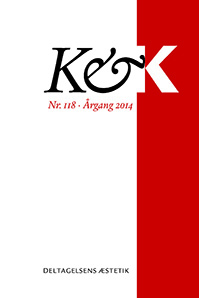At jamme med byens rytmer – selvorganiserede forhandlinger af tid og rum
DOI:
https://doi.org/10.7146/kok.v42i118.19841Nøgleord:
self-organization, participation, rhythm analysis, urban space, urban dialectics, embodied practices, unregulated space, sensory ethnographyResumé
Focusing on the city, this article examines the relation between the specific (body and place) and more abstract (time and space), in order to understand how people negotiate the affordances of materiality, space and time. Based on a two year anthropological multi-sited fieldwork, 38 people have shown and told me how they organize themselves in the city through music and dance. Focusing on the phenomenon self-organization as a special form of participation, the main argument of the article stresses that people create their own use of the city by exploring and sensing the social spaces and rhythms of the city. They improvise in their use of places that are not framed institutionally or pre-established in advance. In order to understand how people transform the city into a space for self-organization, the analytical framework of the article is the French neomarxist and urban philosopher Henri Lefebvre's rhythmanalysis. The rhythmanalysis enables us analyze the dialectical relationship between the body and the city. The first part of the article analyzes three spatial elements of the self-organized practice: How spaces become exciting, the framing of a space through sound and light and the embodied exploration of space. Secondly, the article combines observations from a jam session with Lefebvre's rhythmanalysis and specifies the main argument of the article: self-organization is a practice of improvisation and is conceptualized as a way of “jamming with urban rhythms.”
Downloads
Publiceret
Citation/Eksport
Nummer
Sektion
Licens
Tidsskriftet følger dansk ophavsret.





